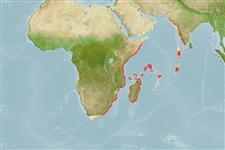Teleostei (teleosts) >
Perciformes/Serranoidei (Groupers) >
Anthiadidae (Fairy basslets or Streamer basses)
Etymology: Nemanthias: Greek, nema, .atos = filament + Greek, anthis = a fish, Sparus aurata (Ref. 45335).
Eponymy: Smith’s etymology says only that the fish was: “…Named for J E Carberry of Malindi, Kenya who greatly assisted my work. [...] (Ref. 128868), visit book page.
More on author: Smith.
Environment: milieu / climate zone / depth range / distribution range
Ecology
Marine; reef-associated; depth range 4 - 30 m (Ref. 9710), usually 10 - 30 m (Ref. 4319). Tropical
Western Indian Ocean: widespread in the area, east to the Maldives and south to South Africa.
Size / Weight / Age
Maturity: Lm ? range ? - ? cm
Max length : 13.0 cm TL male/unsexed; (Ref. 9710)
Found in groups off outer reef slopes (Ref. 9710).
Life cycle and mating behavior
Maturity | Reproduction | Spawning | Eggs | Fecundity | Larvae
Heemstra, P.C. and J.E. Randall, 1986. Serranidae. p. 509-537. In M.M. Smith and P.C. Heemstra (eds.) Smiths' sea fishes. Springer-Verlag, Berlin. (Ref. 4319)
IUCN Red List Status (Ref. 130435: Version 2024-1)
Threat to humans
Harmless
Human uses
Tools
Special reports
Download XML
Internet sources
Estimates based on models
Preferred temperature (Ref.
123201): 24.3 - 27.9, mean 26.7 °C (based on 80 cells).
Phylogenetic diversity index (Ref.
82804): PD
50 = 1.0000 [Uniqueness, from 0.5 = low to 2.0 = high].
Bayesian length-weight: a=0.01349 (0.00618 - 0.02945), b=3.00 (2.81 - 3.19), in cm total length, based on LWR estimates for this (Sub)family-body shape (Ref.
93245).
Trophic level (Ref.
69278): 3.4 ±0.45 se; based on food items.
Resilience (Ref.
120179): High, minimum population doubling time less than 15 months (Preliminary K or Fecundity.).
Fishing Vulnerability (Ref.
59153): Low vulnerability (10 of 100).
Nutrients (Ref.
124155): Calcium = 98.6 [54.5, 193.5] mg/100g; Iron = 0.859 [0.469, 1.498] mg/100g; Protein = 18.1 [16.2, 19.7] %; Omega3 = 0.161 [0.097, 0.266] g/100g; Selenium = 23.8 [13.7, 46.2] μg/100g; VitaminA = 207 [70, 669] μg/100g; Zinc = 1.6 [1.1, 2.3] mg/100g (wet weight);
